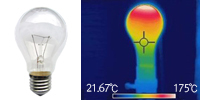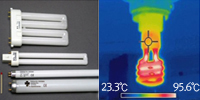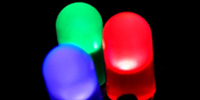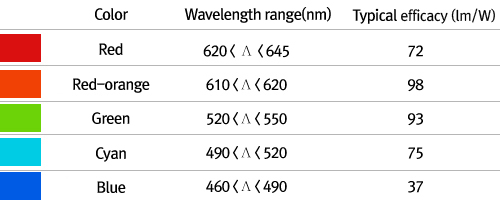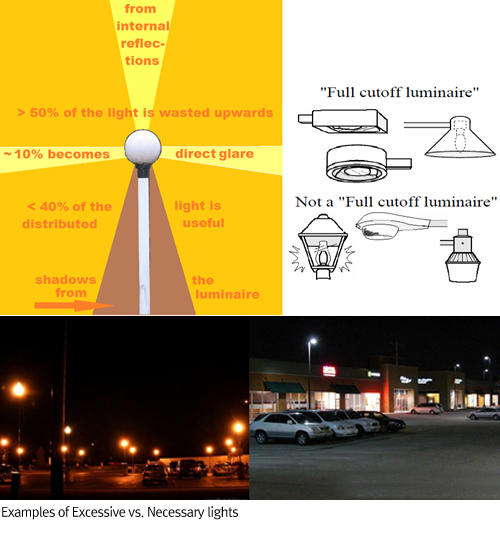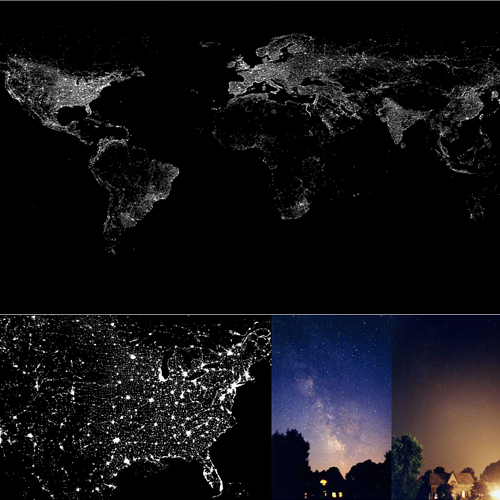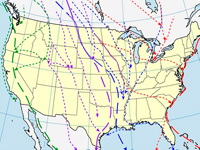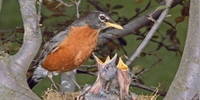-
A sponsoring agency : FLORIDA ATLANTIC UNIVERSITY OBSERVATORY
Collaboration and translation : Eric Vandernoot (Atlantic Observatory), Han Soul Lee (Florida Atlantic University Physics Department)What is light pollution?
Light pollution is the use of excessive amounts of light from manmade sources in the outdoor environment. There are two ways that light pollution interferes with our ability to study the sky. As such, it becomes harder to:"See fainter objects" "Do spectroscopy"

Figure 1.
A map of the world, showing the extent of light pollution. The brighter a region is, the worse light pollution is for astronomical observations.Sky glow is the orange glow seen over towns and cities. It is caused by light being reflected of the ground or other sources and by being scattered off of molecules in the atmosphere. Naturally, the sky is never perfectly dark. The sunlight scattered by the dust in the solar system and excited oxygen atoms in the upper-atmosphere creates a natural sky glow. However, sky glow over time has been increasing due to an increase in heavily populated areas. A look at this map of Earth, showing the regions affected by light pollution.
-
In heavily populated areas, more inefficient, careless practices and poorly designed outdoor light fixtures increase the amount of sky glow through direct upward emission, wasted light falling into areas that do not need illumination, and over-illumination.
The following pictures are some examples of sky glow and poor use of outdoor light fixtures.
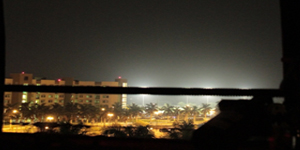
Figure 2.
Imaged above is Henderson Athletic Field on Feb. 12, 2013 with lights so bright and poorly designed that it is setting the sky aglow.

Figure 3.
Imaged on the left is the same field with its light so bight that the full moon (the orange ball) on Sept. 13, 2011 is hardly noticable.
This increase in sky glow is enough reduce the amount of stars we can see and makes it difficult to view dim objects in the sky. Sometimes, the sky glow is too bright to clearly see very dim objects like nebulas or galaxies.
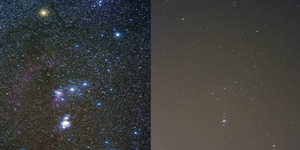
Figure 4.
The constellation Orion, imaged at left from dark skies, and at right from the teeming metropolis of Orem, UT in February 2008
For amateur and professional astronomers alike, this decrease number of visible stars affects observations. Light pollution has forced astronomers to either be content with fewer visible stars or move to areas with darker skies. Unfortunately, the new giant telescopes are being built in more remote areas such as in Chile, Arizona, Hawaii, and the Canary Islands.Spectroscopy is the most valuable tool an astronomer can have. It is used to find out a wide range of information on an object. By studying the spectrum of objects like galaxies, astronomers can determine the chemical composition and temperatures of the objects they observe. They can also determine how fast the object is moving by calculating the red shift of the lines. This becomes difficult to do because the spectrum of the outdoor light sources interferes with the spectra of an object.
The type of light that is being emitted by a light source is very important to astronomers. Low-pressure sodium and high-pressure sodium lamps are preferred because they leave large parts of the spectrum relatively unpolluted, whereas broad-spectrum sources like broadband metal halide, white LED, and incandescent lamps do not. In addition, broad-spectrum sources emit shorter wavelengths that more strongly scatter in the atmosphere.

Figure 5.
Spectral power distributions of four different type lamps.
A: Warm-white fluorescent tube (CCT = 3000 K)
B:Cold-white fluorescent tube (CCT = 6500 K)
C: High-pressure sodium (HPS) lamp used in outdoor public lighting D: Metal-halide lamp used for various outdoor lighting applications.
Tips to Reduce Light Pollution
01. Position lights so that they are pointed downwards where it is needed
02. Use full cutoff light fixtures to better control
03. Use motion-sensor lights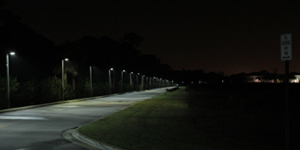
Figure 6.
The image, taken on Jan. 5, 2013, of the back driveway of Imagine Schools Chancellor Campus in Boynton Beach is an example of properly positioned lights with very little glare.

